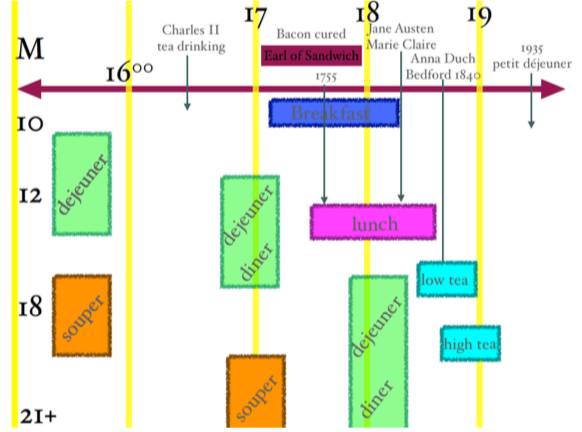Mealtimes through the ages
During the middle ages it was customary to eat just two meals per day. These were ‘disjejunare’ and ‘souper’. The Spanish word for breakfast, desayunar, is derived from ‘disjejunare’. However, when we look at the adulterations of this word we arrive at the two words ‘déjeuner’ and ‘diner’.
These two french words could mean lunch or dinner depending on where in France you lived. Similarly in the United Kingdom, dinner can mean the meal taken at midday for those living in in the North, with ‘Tea’ or Supper being the meal taken in the evening.

Supper is likely to come from the from word ‘souper’ which would describe the meal taken before night fall. In the middle ages déjeuner was the meal that broke the fast with the word ‘jeuner’ meaning ‘to fast’. This meal was taken anytime between 10am and 2pm and was a variable feast consisting of anything from milk, ale, yoghurt, cheese, bread, and meat. Between the 16 and 1800s, aristocratic court life in France and UK had a dramatic effect on meal times.
It was fashionable to eat late as this was said to portray a person of leisure that presumably did not have to get up early in the morning to work. The King of France typically ate dinner at 10pm. The definition of morning was anything that happened before dinner, hence if dinner was taken at around 6 pm, the matinée performances in theatres happened in the afternoon - this is why the afternoon shows are still called matinée.
As dinner was pushed later, lunch made an appearance first with Lord Bacon who asked for meat between two pieces of bread and then more elaborate fork lunches being eaten by the ladies of the day. Anna the Duchess of Burford is credited with introducing ‘tea’, consisting of little cakes and sandwiches, and eaten with lady friends to fill the gap whilst waiting for dinner, although the ‘gouter’ in France was suggested for children at this time of day also.
In the UK, hotels would describe this ‘low tea’ as the meal eaten at low tables with ‘high tea’ describing dinner. So what happened to the breakfast we know today? It’s interesting to note that petit- déjeuner (breakfast) only makes an appearance in the French dictionary in 1935. In the UK, the gentry would hold lavish ‘wedding breakfasts’, and by the 1830s a sit down breakfast became more common with the growing middle classes wanting to emulate the aristocracy. It seems clear that eating every few hours is something we invented over the last few centuries.
